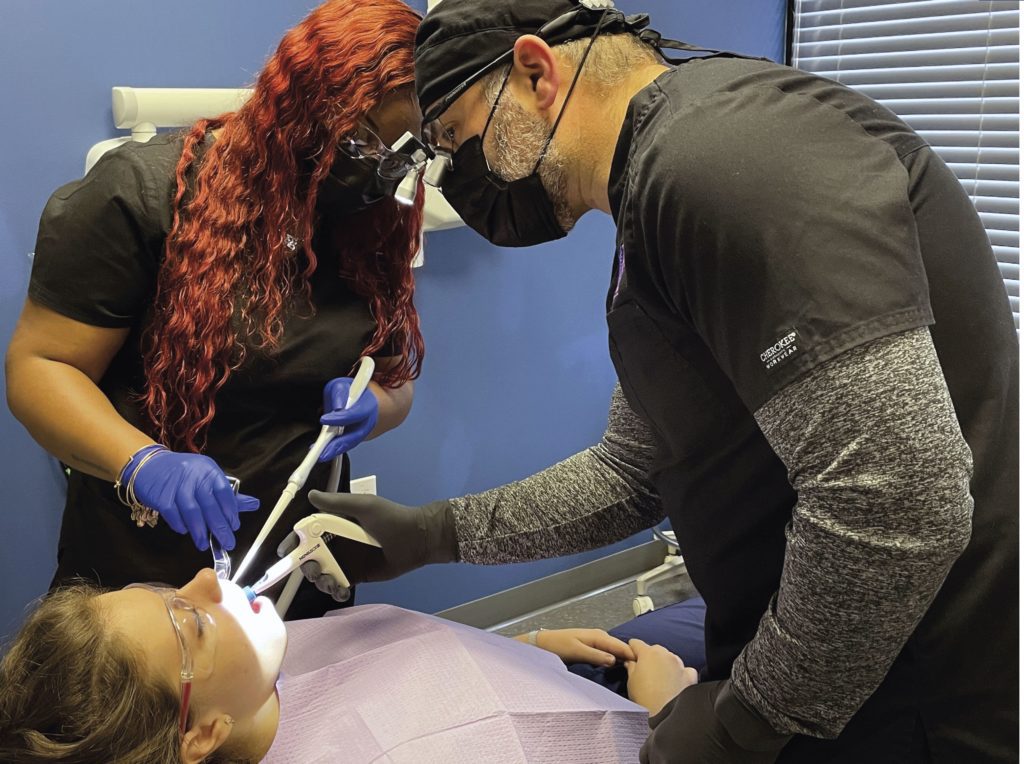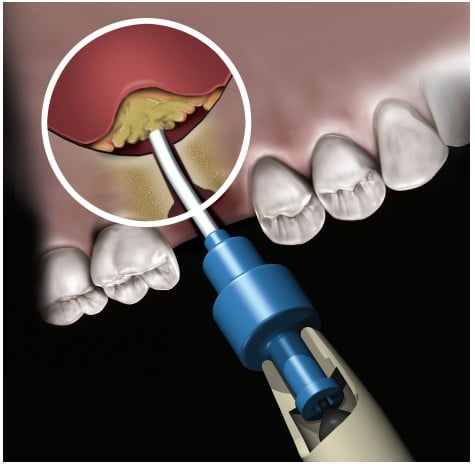Dr. Isaac Tawil uses NovaBone Putty in many aspects of his implant practice. Read how this can lead to a more successful implant process in this conversation.
Dr. Isaac Tawil discusses his practice’s focus on dental implantology and the role certain dental biomaterials play in his armamentarium
As a general practitioner, what piqued your interest in dental implants and regenerative procedures?
As a private practice clinician, I often referred out many cases for dental implant therapy to local oral surgeons and periodontists. Many of these cases seemed simple enough; however, they required lengthy treatments. Often patients declined referrals due to length of treatment. Additionally, they did not want to be treated by another dentist. As I joined dental implant associations and received didactic/surgical training, I learned more about simplifying dental implantology and digital dentistry, including guided surgery. As my knowledge and experience grew, I challenged myself and my clinic to provide faster solutions to previously lengthy treatment modalities. With more time and experience, I took on larger and more complex cases requiring augmentations to existing alveolar bone.

What types of bone grafting procedures do you do in your clinical practice?
As the practice has a focus on implant therapy, a wide array of bone-grafting procedures is necessary. Sometimes the procedures are rather simple such as grafting an extraction socket for future placement of an implant. It is also common to correct dehiscence or fenestration-type defects at the time of implant placement. The more advanced procedures would include localized ridge augmentations to correct ridge deficiencies and sinus augmentations — both lateral window and crestal approaches. As some implants may experience bone loss as a result of peri-implantitis, the ability to treat these implants and graft the defect has become a necessary treatment modality.

There is a plethora of bone grafting materials available to a practitioner. Do you have a preference for a particular material, and why?
I use a variety of materials in the practice, and my selection really comes down to the indication. If I’m grafting a defect or deficiency in the esthetic zone, I may choose to use a material that doesn’t exhibit much resorption over time such as a mineralized allograft or xenograft. In other cases, such as an extraction socket where an implant will be placed in a delayed protocol, I want to use a material that turns over to vital bone in a reasonable time period, so the implant is placed in bone versus inorganic material. There are also some procedures such as a crestal sinus augmentation, where the handling characteristics and delivery system for the graft can play a key role in my choice of material.
So what kind of material would you use in a procedure such as a crestal sinus augmentation, and why?
When choosing a procedure such as crestal sinus augmentation, a sufficient ridge height is required (e.g., > 4 mm). I prefer the crestal approach to sinus augmentation over the lateral window approach because the former is much less traumatic for the patient and in my experience has resulted in fewer complications. In these crestal approaches, we penetrate the maxillary ridge with crestal kits, osteotomes, or specialized burs (e.g., Densah® burs by Versah). We then need to find a way to atraumatically elevate the floor of the sinus and graft the site to produce sufficient bone volume for placement of a dental implant. NovaBone® makes a synthetic bioactive glass putty material that is really ideal for this indication. During insertion of this material, a form of hydrostatic pressure is created that naturally lifts the sinus and creates a dome of graft material that can surround the implant.

There are a number of allograft putties and other synthetic putties available on the market, so what makes the NovaBone material unique?
It has a lot to do with the delivery system and the material properties of this bone graft. The putty is available in cartridges that allow the material to be expressed using a dispensing gun provided by the company. The cartridge has a slightly curved cannula that is 1.8 mm in diameter. This allows the material to be precisely expressed through the pilot hole that we’ve created in the maxillary ridge. Clinicians are familiar with this form of material delivery for other dental materials such as composites, but I believe NovaBone is the only company in the world that offers the delivery of bone-grating material in a cartridge-based system. The NovaBone Dental Putty also is radiopaque, so I can easily see the graft surrounding the dental implant on an intraoperative radiograph. This material also resorbs and turns over into host bone at rate the does not jeopardize the stability of the implant.

Do you use NovaBone graft materials in other procedures?
Yes. The NovaBone Dental Putty can also be used in extraction sockets, filling the gap of immediate implant placement-partial extraction therapy or for the treatment of peri-implant defects. The unique delivery system also proves helpful when addressing these defects in the posterior zone with compromised access. The putty material is also available in a standard syringe or clamshell packaging for those scenarios where the cartridge-based delivery may not be necessary. The company also offers their material in a granule form — it’s the same basic bioactive glass technology, but in more of a particulate form with interconnected porosity. This form of the material holds dimension well and is preferred by some clinicians for indications such as localized ridge augmentation.

For those not familiar with bioactive glass materials, can you provide a simple primer?
Bioactive glass materials have been used in dentistry for several decades. Unlike some other parts of the world, the U.S. market seems more focused on allografts (cadaveric bone) or xenografts (bovine or porcine origin). I never totally understood this, as materials, such as NovaBone, offer consistency, no risk of disease transmission, are visible on a radiograph, turn over into native bone, and are osteostimulatory — all are really important attributes for a bone graft material.
The NovaBone material consists of dual-sized particles of calcium phosphosilicate (CPS). The putty formulation adds polyethylene glycol and glycerin to provide the necessary binding of the particles and handling characteristics with the particles making up 70% by volume. Numerous in vivo studies have demonstrated that the CPS particles impart an osteostimulatory effect at the wound site. At the time of implantation, the graft does not harden like a cement but rather is adaptable to the defect space and provides a transient hemostatic effect. Calcium and silicon ions are immediately released into the wound site that help stimulate the attraction of undifferentiated cells, ultimately resulting in a transformation and proliferation of osteoblasts. Within days, the binder is absorbed, leaving a three-dimensional scaffold for bone regeneration. At this vascularized graft site, the smaller particles of CPS release calcium and phosphate ions that further contribute to bone formation. The larger particles of CPS remain in the wound site longer, providing ongoing release of calcium and phosphate ions and helping to ensure the graft does not lose volume prematurely. This stimulatory phenomenon is not found in many bone graft materials that only provide an osteoconductive or scaffolding capacity.
You make some compelling points for this particular synthetic graft material. Why do you think the market hasn’t shifted to such a material?
The answer is probably multifaceted. Allografts are very popular in the United States because the bone is from another human being. That’s easy to explain to patients, and in general these grafts are highly biocompatible. The demineralized forms of allograft also demonstrate an osteoinductive effect, which is similar to NovaBone’s osteostimulatory effect albeit a slightly different mechanism of action. I think xenografts became popular because the inorganic content and structure are similar to human bone as well as a plethora of advertisements through dental journals, conferences, and social media promoting these materials. These grafts do have osteoconductive potential, and for some indications, their slow or non-resorbing characteristics can actually be a benefit. Some of the earlier synthetic graft materials introduced to the dental market had a mixed success rate, and this may have poisoned the well a bit for synthetics in the U.S. The early sintered hydroxyapatites were essentially non-resorbable with limited vital bone at the graft site. There was a potpourri of various calcium sulfates and tricalcium phosphates (TCPs) produced in various ratios. Some of these resorbed too quickly, resulting in a disappointing volume of regenerated bone. Even the early forms of bioactive glass particles used in the treatment of periodontal defects could produce inconsistent results, especially if the graft was overpacked into the defect site. The more modern-day bioactive glass products, like those produced by NovaBone, have corrected for these historical deficiencies and nicely align with all the desirable characteristics for a dental bone graft material.
It seems that you also have a passion for teaching. Tell us a little about that.
Yes, I’ve had the good fortune to be able to lecture around the world on advanced dental implant procedures, often incorporating the latest dental technology. Through my private practice and Advanced Dental Education — the latter being an educational enterprise that I founded along with my partner, world-renowned dental expert Dr. Scott Ganz — we are able to do hands-on and live surgical courses to impart my experience to others. I’m a big believer that didactic lectures alone do not adequately prepare a clinician to perform the gamut of dental implant procedures, so I offer educational venues and opportunities where clinicians can get some hands-on experience. Those interested can learn more at https://www.aiedental.com.
Read more about NovaBone Putty and other NovaBone Products in this corporate profile — https://implantpracticeus.com/novabone-products/
Stay Relevant With Implant Practice US
Join our email list for CE courses and webinars, articles and mores


